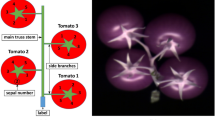Abstract
Apple scab prediction is based on the model of Mills which describes the risk of Venturia inaequalis infection using leaf wetness duration and air temperature data. The quality of prognosis relies on sensor quality. Six brands of commercially available leaf wetness sensors were compared at the Julius Kuehn-Institute (Germany) apple orchard from 2011 to 2013. Also a new wetness sensor was developed and optimized from 2009 to 2015 in cooperation with Thies Clima company. The Thies-wetness sensor was equipped with a glass–ceramic surface, an adjustable heating system to avoid dew and an adjustable cooling system to prolong wetness duration of sensor surface. Prototypes were tested in climate chamber before exposition in the orchard to achieve sensor settings with drying properties broadly similar to apple leaves. The market-ready prototype showed suitability for prognosis in field assays in primary seasons of 2015–2017 and maybe integrated into prognosis of apple scab without further modeling. The Thies-sensor was shown to be more reliable, uniform, sensitive and more suitable for forecasting than the purchased models.





Similar content being viewed by others
References
Alt S, Kollar A (2010) Hydrodynamics of raindrop impact stimulate ascospore discharge of Venturia inaequalis. Fungal Biol 114:320–324. https://doi.org/10.1016/j.funbio.2010.01.009
Batzer JC, Gleason ML, Taylor SE, Koehler KJ, Monteiro JEBA (2008) Spatial heterogeneity of leaf wetness duration in apple trees and its influence on performance of a warning system for sooty blotch and flyspeck. Plant Dis 92:164–170. https://doi.org/10.1094/PDIS-92-1-0164
Brook P (1966) The ascospore production season of Venturia inaequalis (Cke.) Wint., the apple black spot fungus. N Z J Agric Res 9:1064–1069
Brook P (1969a) Effects of light, temperature, and moisture on release of ascospores by Venturia inaequalis (Cke.) Wint. N Z J Agric Res 12:214–227. https://doi.org/10.1080/00288233.1969.10427090
Brook PJ (1969b) Stimulation of ascospore release in Venturia inaequalis by far red light. Nature 222:390–392
DeBary HA (1853) Untersuchungen über die Brandpilze und die durch sie verursachten Krankheiten der Pflanzen mit Rücksicht auf das Getreide und andere Nutzpflanzen. Habilitation
Frey C, Keitt G (1925) Studies of spore dissemination of Venturia inaequalis (Cke.) Wint. in relation to seasonal development of apple scab. J Agric Res 30:529–540
Gadoury DM, Seem RC, Stensvand A (1994) Ascospore discharge in Venturia inaequalis. Nor J Agric Sci Suppl 17:205–219
Getz R (1992) Report on the measurement of leaf wetness, vol 38. World Meteorological Organisation, Agricultural Meteorology, Genf
Hirst JM, Stedman OJ (1962) The epidemiology of apple scab (Venturia inaequalis (Cke.) Wint.). Ann Appl Biol 50:525–550. https://doi.org/10.1111/j.1744-7348.1962.tb06047.x
Huber L, Gillespie TJ (1992) Modeling leaf wetness in relation to plant disease epidemiology. Annu Rev Phytopathol 30:553–577. https://doi.org/10.1146/annurev.py.30.090192.003005
Jones AL (1986) Role of wet periods in predicting foliar diseases. In: Leonard KJ, Fry WE (eds) Plant disease epidemiology. MacMillan Publishing Company, New York, pp 87–100
Keitt GW, Jones LK (1926) Studies of the epidemiology and control of apple scab. Wis Agric Exp Stn Res Bull 73:1–104
Kohl R (1993) Untersuchungen zur Epidemiologie des Apfelschorfs (Venturia inaequalis (Cke.) Wint.)
Kollar A (1997) Present research on the most important pathogen on apple, the apple scab fungus Venturia inaequalis. Plant Res Dev 46:88–96
Kollar A (1998) A simple method to forecast the ascospore discharge of Venturia inaequalis. Z Pflanzenk Pflanzen 105:489–495
MacHardy WE (1996) Apple scab. Biology, epidemiology and management. The American Phytopathological Society, St. Paul
MacHardy WE, Gadoury DM (1986) Patterns of ascospore discharge by Venturia Inaequalis. Phytopathology 76:985–990
MacHardy WE, Gadoury DM (1989) A revision of Mills’ s criteria for predicting apple scab infection periods. Phytopathology 79:304–310
Madeira AC, Kim KS, Taylor SE, Gleason ML (2002) A simple cloud-based energy balance model to estimate dew. Agric For Meteorol 111:55–63. https://doi.org/10.1016/S0168-1923(02)00004-7
Magarey RD, Seem RC, Weiss A, Gillespie TJ (2005) Estimating surface wetness on plants. In: Hatfield JL, Baker JM (eds) Micrometeorology in Agricultural Systems. American Society of Agronomy, Madison
Miller P, Waggoner P (1958) Dissemination of Venturia inaequalis ascospores. Phytopathology 48:416–419
Mills WD (1944) Efficient use of sulfur dusts and sprays during rain to control apple scab Cornell Ext. Bulletin 630:2–4
Moore M (1958) The release of ascospores of apple scab by dew. Plant Pathol 7:4–5
Roßberg D (2008) Neptun 2007—Obstbau Berichte aus dem Julius Kuehn-Archiv 147
Roßberg D, Harzer U (2015) Erhebungen zur Anwendung von Pflanzenschutzmitteln im Apfelanbau. Journal für Kulturpflanzen 67:85–91
Rossi V, Ponti I, Marinelli M, Giosue S, Bugiani R (2001) Environmental factors influencing the dispersal of Venturia inaequalis ascospores in the orchard air. J Phytopathol 149:11–19
Rowlandson T, Gleason M, Sentelhas P, Gillespie T, Thomas C, Hornbuckle B (2015) Reconsidering leaf wetness duration determination for plant disease management. Plant Dis 99:310–319. https://doi.org/10.1094/PDIS-05-14-0529-FE
Sentelhas PC, Gillespie TJ, Gleason ML, Monteiro JE, Helland ST (2004) Operational exposure of leaf wetness sensors. Agric For Meteorol 126:59–72
Sutton TB, Aldwinckle HS, Agnello AM, Walgenbach JF (2014) PART I: infectious diseases. In: Sutton TB, Aldwinckle HS, Agnello AM, Walgenbach JF (eds) Compendium of apple and pear diseases and pests, Second edn. Diseases and pests compendium series. The American Phytopathological Society, St. Paul, pp 8–116. https://doi.org/10.1094/9780890544334.002
Acknowledgements
We thank K. Piwowarczyk for technical assistance, F. M. Porsche for comments, A. Engelhardt for collection of leaves, and M. Ehlert and T. Ehlert for proof reading.
Funding
The project was supported by funds of the German Government’s Special Purpose Fund held at the Landwirtschaftliche Rentenbank.
Author information
Authors and Affiliations
Corresponding author
Ethics declarations
Conflict of interest
The authors declare that they have no conflicts of interest.
Human and animal rights
This article does not contain any studies involving animals or human participants performed by any of the authors.
Declaration of authorship
All authors agree with this publication.
Additional information
Publisher's Note
Springer Nature remains neutral with regard to jurisdictional claims in published maps and institutional affiliations.
Rights and permissions
About this article
Cite this article
Ehlert, K., Himmelmann, L., Beinhorn, J. et al. Comparison of wetness sensors and the development of a new sensor for apple scab prognosis. J Plant Dis Prot 126, 429–436 (2019). https://doi.org/10.1007/s41348-019-00239-3
Received:
Accepted:
Published:
Issue Date:
DOI: https://doi.org/10.1007/s41348-019-00239-3




